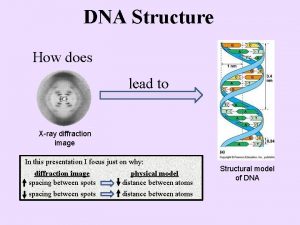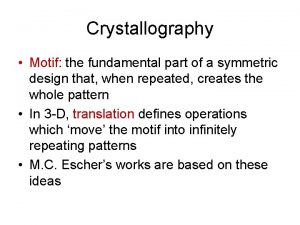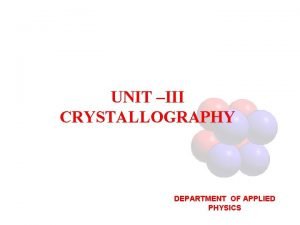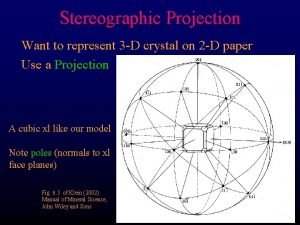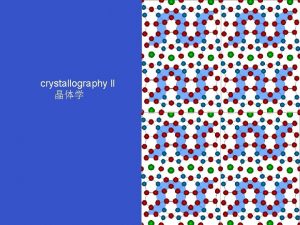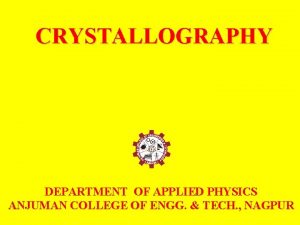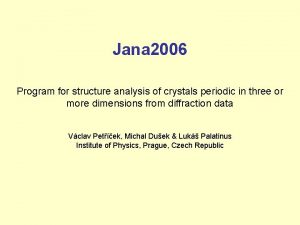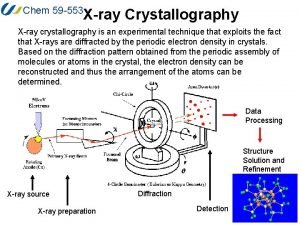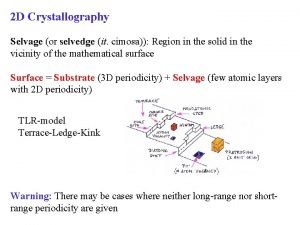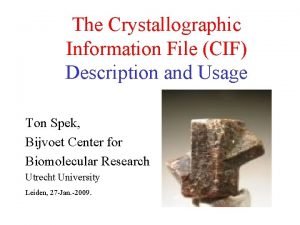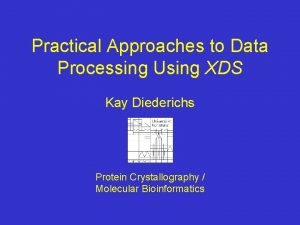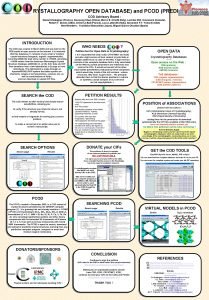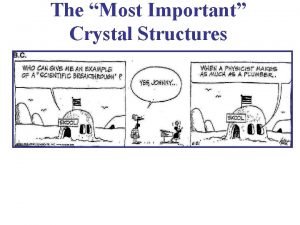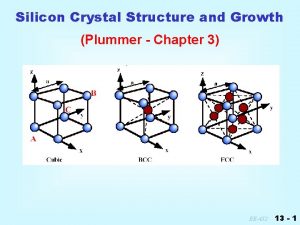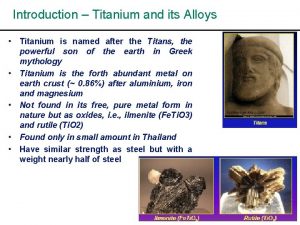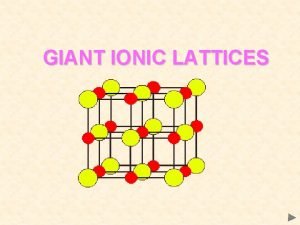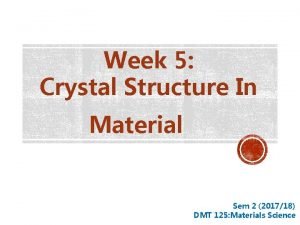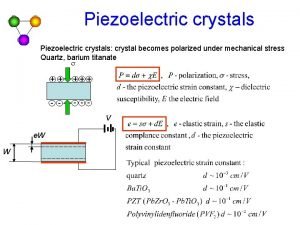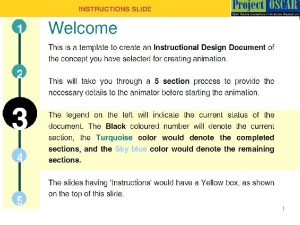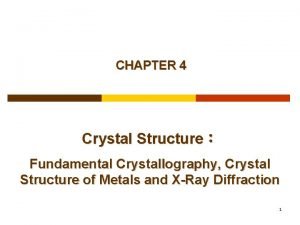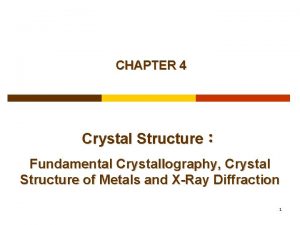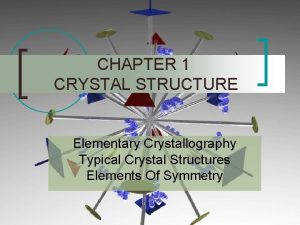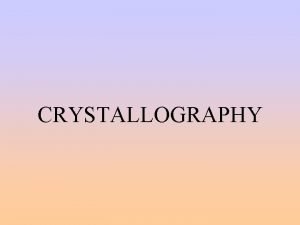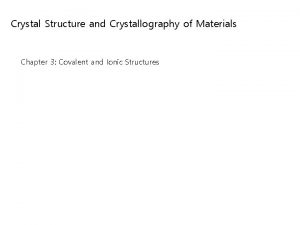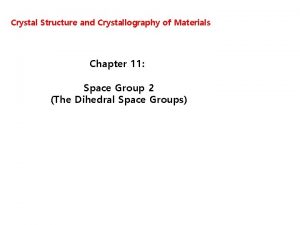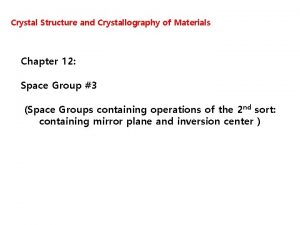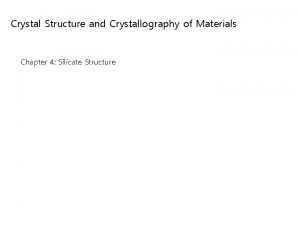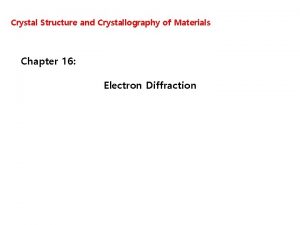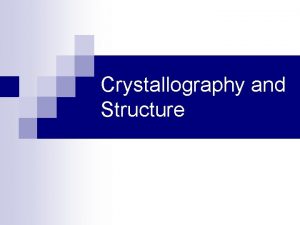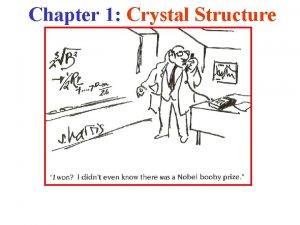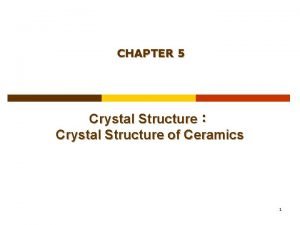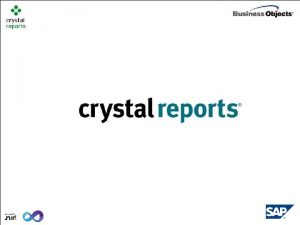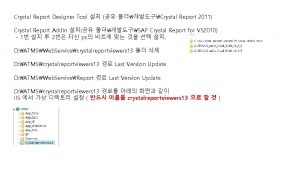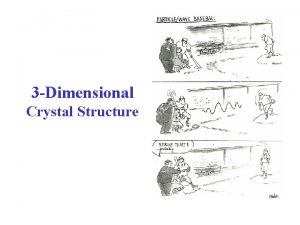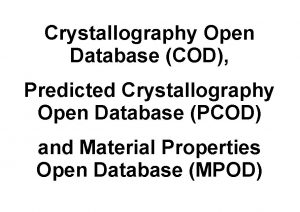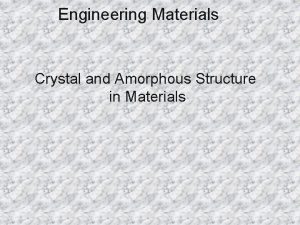Crystal Structure and Crystallography of Materials Chapter 11
























- Slides: 24

Crystal Structure and Crystallography of Materials Chapter 11: Space Group 2 (The Dihedral Space Groups)

Combinations involving non-parallel rotations When 2 -fold rotations about axes A and B, which intersect at an angle μ, are combined, the result is a rotation of 2μ about a perpendicular axis C’. 2μ 2μ

Now, consider the general combination of two screws Aa, t 1 and Bb, t 2 Aα, t 1 = t 1 · Aα Bβ, t 2 = Bβ · t 2 ∴ Aα, t 1 · Bβ, t 2 = t 1 · Aα · Bβ · t 2 = t 1 · C’γ · t 2 C” B Now, consider the way the translation t 1 transforms a rotation of γ about C, t 1+t 2 C t 1 C’ μ t 2 t 1 -1 C γ t 1 = C’γ Premultiply both sides by t 1, giving A t 1 -1 Cγ t 1 = t 1 C’γ → Cγ t 1 = t 1 C’γ ∴ Aα, t 1 · Bβ, t 2 = Cγ · t 1 · t 2 Standard form of a rotation, Cγ, followed by a translation t 1+t 2

When α and β of (9) are both π, then axis C is perpendicular to the plane of A and B, so that t 1+t 2 has no component parallel to C. ∴ Aπ, t 1 · Bπ, t 2 = C” 2μ The result of combining two 2 -fold screws whose axes A and B intersect at an angle μ is a rotation of 2μ about an axis C” normal to the plane of A and B. The location of C” with respect to C is found, Effect of Displacing an Axis Now, we generalize the previous results with the screws which do not intersect. → necessary to know how the result of a rotation of α about an axis A compares with the result of a rotation of the same amount about a parallel axis s. A, separating axis.

The effect of displacing a rotation axis Aα by s. Rotation of α about a displaced axis is same as the rotation about an undisplaced axis, followed by a perpendicular translation. s. A s α A α · T ┴ = s. A α α/2 where, A A’

Combinations of Operations of Two non-intersecting 2 -fold Screws Find the results of combining two screw motions about axes which do not intersect, and which makes an angle μ with one another. 1) When the rotation components of both screws are π. → combine Aπ, t 1 with s. Bπ, t 2 = s. Bπ, t 2 · T┴ where,

Space Groups Isogonal with 222: Aπ, t 1 · s. Bπ, t 2 = C”π, 2 s The space groups isogonal with 222 are derived by combining the axial sets of Fig. 4 with the translations of the orthorhombic lattices D, C, I, and F.

Space Groups Isogonal with 222: First, consider the possible combination of 2 m 2 m 2 m with P. → P 222, P 2221, P 21212 and P 212121 Can be made by the combinations in the top and bottom rows of Fig. 4.

Space Groups Isogonal with 222: Next, consider the possible combinations of 2 m 2 m 2 m with a lattice having one face centered → let the centered face be C.

Space Groups Isogonal with 222: When a screw Aα, t 1, is placed at A, its translation equivalent occurs at A” and a screw of Aα, t 1+T 11 arises at A’ → if A is a rotation, A’ is a screw, and vice versa → Thus the A axes of Fig. 9 must be arranged in vertical sheets such that rotation axes and screw axes are alternately encountered from left to right. → A similar discussion leads to a similar relation of B axes. → possibilities: C 222 m, C 2212 m, C 21212 m Note that C 222 = C 2122 = C 2212 = C 21212 C 2221 = C 21221 = C 22121 = C 212121 → m assure 0 or 1.

Space Groups Isogonal with 222:

Space Groups Isogonal with 222: Next, consider the combinations of 2 m 2 m 2 m with the translation of lattice I. Each of the A, B, and C” axes, combined with the translations of I must give rise to Fig. 11 pattern of axes. → It only remains to see how A, B, and C” are related in space.

Space Groups Isogonal with 222: Show that I 222 = I 21212 I 2221 = I 212121

Space Groups Isogonal with 222: Consider the combination of 2 m 2 m 2 m with the translations of F. F 222 = F 2221 = F 212121

Space Groups Isogonal with point group 32: The order of listing the axis is C”AB, where A and B axes are equivalent through the operations of axis C”. → Can be derived by combining 3 m 2 m 2 m with each of the two lattices P and R.

Space Groups Isogonal with point group 32: Through each lattice point, there is a set of three 2 -fold axis along each a axis and 3 more 2 -fold axes along the long diagonals of the diamond meshes.

Space Groups Isogonal with point group 32: Consequently there are two permissible orientations of 32 with respect to lattice P. → the last position of the list of space-group symbols is accepted as the position of the axis along the cell diagonal. 3 2 1 : two fold axes along the cell axis. 3 1 2 : two fold axes along the cell diagonal. P 3 m 2 m 1 and P 3 m 12 m

Space Groups Isogonal with point group 32: The combination of the lattice translations and the 3 m produce a pattern of 3 m’s like P 31. The 2 -fold rotation axes intersect the 3 m screws according to the Fig. 15. Fig. 17 illustrate the result of combining the operation Aπ, with a nonparallel axial translation: A screw Aπ, a/2 occurs halfway along a translation. → screws and pure rotation alternate. (need explanation based on Fig 17) From Fig. 17 and Fig. 15, it becomes clear that any combination P 3 m 21 contains P 3 m 211. → all space groups with a primitive lattice and orientation 321 can be derived by using Fig. 17 and fitting the separation, s, between 2 -fold axis of the upper right of Fig. 15, to the 3 -fold screws of P 3, P 31, P 32. → results P 321, P 3121, and P 3221

Space Groups Isogonal with point group 32: 2/6 1/6 1/6 2/6 2/6

Space Groups Isogonal with point group 32: Consider P 3 m 12: the scheme of combination of any 2 -fold screw A is shown in Fig. 21 → non-parallel translation in (001) cause an alteration of parallel rotations and screws lying in this plane. → P 3 m 12 contains the combination P 3 m 121. → the three space groups P 312, P 3112, and P 3212 result.

2/6 1/6 2/6 5/6 1/6 Where 5/6=2/6. 4/6 5/6 5/6 4/6 1/6 5/6

Space Groups Isogonal with point group 32: The lattice R translation → symmetry 3 m 2 m → has only one set of three 2 -fold axis which occur parallel to the edges of the diamond-shaped triple cell. The possible space groups R 3 m 2 m are obtained by combining the translations of R with each of the possible axial combinations of Fig. 15. 1) Consider upper left axial set, which gives R 32. → (Fig. 25) contains all combinations shown in Fig. 15 ∴ R 32 = R 312 = R 321 = R 3121 = R 3221

Space Groups Isogonal with point group 32: 2/6 1/6 1/6 2/6 1/62/62/6 1/6

Space Groups Isogonal with point group 422, 622, and others: I will leave it up to you.
 Dna x-ray crystallography
Dna x-ray crystallography Motif crystallography
Motif crystallography Site:slidetodoc.com
Site:slidetodoc.com Stereographic projection crystallography
Stereographic projection crystallography Crystallography types
Crystallography types Crystalline vs non crystalline
Crystalline vs non crystalline Crystallography engineering physics
Crystallography engineering physics Jana crystallography
Jana crystallography Crystallography
Crystallography Crystallography
Crystallography Crystallography information file
Crystallography information file Xds data processing
Xds data processing X-ray crystallography
X-ray crystallography Cod crystallography
Cod crystallography Natural materials and man made materials
Natural materials and man made materials Useful but harmful materials
Useful but harmful materials Natural man made
Natural man made Adapting and adopting materials
Adapting and adopting materials Diamond zinc blende structure
Diamond zinc blende structure Silicon crystal structure
Silicon crystal structure Titanium crystal structure
Titanium crystal structure Giant ionic lattice examples
Giant ionic lattice examples Bcc crystal structure
Bcc crystal structure Piezoelectric crystal atomic structure
Piezoelectric crystal atomic structure Basis in crystal structure
Basis in crystal structure
